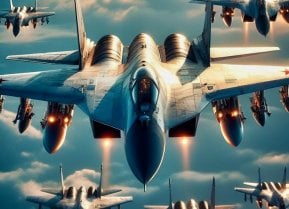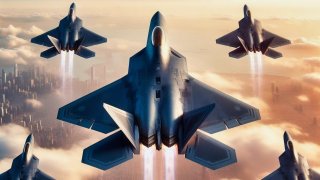NGAD: The F-22 Raptor Stealth Fighter on 6th Generation 'Steroids'?
It should be said the F-22's development and experience will heavily influence the NGAD. Some experts even say the NGAD will be the F-22 on steroids, as it will take what the Raptor can do and do it better.
NGAD will be heavily influenced by the mighty F-22 Raptor stealth fighter: The Lockheed Martin F-22 Raptor has been routinely described as the best air superiority fighter ever produced, while the first "fifth-generation" aircraft also incorporates ground attack, electronic warfare, and signals intelligence capabilities.
In its nearly 20 years in service, it has never been employed in aerial combat and has only been used in a ground attack role – dropping 1,000-pound GPS-guided bombs on Islamic State targets as part of Operation Inherent Resolve, the American-led intervention in Syria. From September 2014 to July 2015, the F-22 conducted 204 sorties over Syria, dropping 270 bombs at some 60 locations.
Given that the F-22 remains such a capable warbird – albeit one that hasn't bared its claws in an actual dogfight – the question would be why the United States Air Force has been so focused on seeing many of the oldest Raptors retired. The short answer is that the service is looking to the next generation, literally.
F-22: Too Advanced Yet Too Late
The F-22 was both a little ahead of its time, yet arguably a little late for the changing "New World Order."
The F-22 Raptor was developed in the 1980s as part of the United States Air Force's Advanced Tactical Fighter (ATF) program. The aircraft was deemed the best, but it couldn't catch a break. The service originally sought to have 750 in its fleet, but that number was cut back to just 187 production aircraft due to the high cost.
After the end of the Cold War and the dissolution of the Soviet Union, the F-22 Raptor wasn't seen as a priority, and following the 9/11 attacks on New York City and the Pentagon, the United States became embroiled in the Global War on Terror. An air superiority fighter was simply not what the Air Force needed at the time.
Additionally, the Pentagon's ban on exports to protect its advanced technologies and the development of the F-35 Joint Strike Fighter simply meant an end to the program.
More recently, U.S. Air Force officials have noted the fifth-generation stealth aircraft simply lacks the magazine depth as well as the range required to meet the role of the service's air superiority fighter in the next decade.
Looking to the NGAD
It could be argued that the F-22 would be well-suited to a potential conflict with China, which has been focused on developing its own fifth-generation fighter, the Chengdu J-20 (NATO reporting name "Fagin"). Designed as an air superiority fighter with precision strike capability, it is also seen as a capable combat aircraft.
However, the United States Air Force is looking beyond the F-22. By retiring the 32 F-22 Raptors from Block 20 – arguing that those aircraft can't actually be used in combat – the Air Force could save roughly $485 million a year or $2.5 billion over the next five years.That money could be directed to fund the Next Generation Air Dominance (NGAD) program, which has been described as a system of systems that will include a six-generation fighter and autonomous support aircraft. First conceptualized back in 2014 in a DARPA's Air Dominance Initiative study, the NGAD program is designed to achieve air superiority, but the NGAD shouldn't be seen as simply a single aircraft.
Last month, at the POLITICO Defense Summit, U.S. Air Force Secretary Frank Kendall explained that the manned NGAD aircraft will control the uncrewed fighters escorting it. A variety of multi-mission drones, which have been dubbed Collaborative Combat Aircraft (CCA), could act as loyal wingmen, while all of the aircraft could be networked together enhancing the situational awareness for the manned and unmanned craft alike.
Moreover, as previously reported by Maya Carlin, there are likely five different technologies that will be prioritized in the NGAD's fighter design including advanced weapons, stealth, digital design, propulsion, and thermal management. While sixth-generation technology has not been precisely defined, the features in the NGAD program are expected to greatly exceed the capabilities of fifth-generation counterparts.

Moreover, we can expect artificial intelligence (AI) and machine learning (ML) to be incorporated into the NGAD, acting as a co-pilot for the manned aircraft and allowing the unmanned aerial systems (UAS) to act independently. In other words, the drones won't require constant directions from the manned aircraft – they'll follow orders, of course, but still show initiative.
NGAD: Expensive Warbird
The NGAD is also quite similar to the F-22 in that it will be costly - and will build on the success of the F-22. According to the Fiscal Year 2023 (FY23) budget request, the Air Force allocated a total of $1.66 billion for the NGAD program.
Further financial commitments are projected, with an estimated additional expenditure of $11.7 billion earmarked for the years spanning from FY2024 to FY2027. The cost of each plane was not disclosed by Kendall, but is expected to be in the "multiple hundreds of millions."

Achieving "Air Dominance" – a significant step above "air superiority" – will require more than a good aircraft and a very good pilot. It will require that system of systems, and apparently, it will be quite costly. But it could be argued that it is also something we can't afford NOT to achieve and maintain.
Key Point: It should be said the F-22's development and experience will heavily influence the NGAD. Some experts even say the NGAD will be the F-22 on steroids, as it will take what the Raptor can do and do it better.
Author Experience and Expertise
Peter Suciu is a Michigan-based writer. He has contributed to more than four dozen magazines, newspapers, and websites with over 3,200 published pieces over a twenty-year career in journalism. He regularly writes about military hardware, firearms history, cybersecurity, politics, and international affairs. Peter is also a Contributing Writer for Forbes and Clearance Jobs. You can follow him on Twitter: @PeterSuciu.
All images are Creative Commons.


